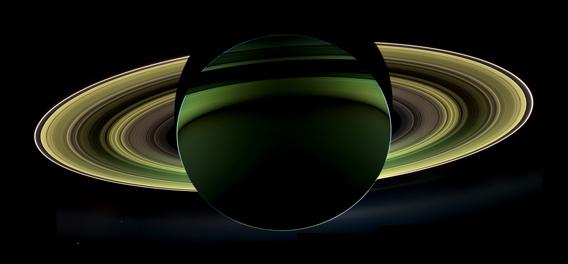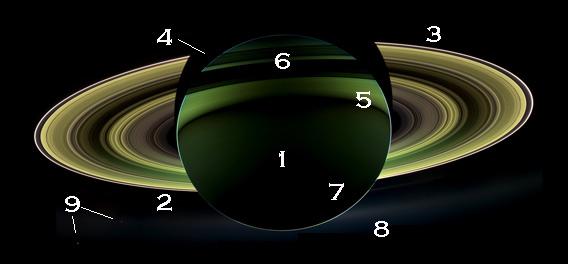I don’t say this very often, but drop whatever it is you’re doing (unless you’re holding another human or a priceless crystal vase) and click this image to embiggen it. Because holy wow.

Image credit: NASA/JPL-Caltech/Space Science Institute
That is Saturn, as seen by the Cassini spacecraft on Oct. 17, 2012. It’s a mosaic of 60 images (taken in violet, red, and infrared light seen here in false color), methodically stitched together to produce this jaw-dropping view, and you absolutely positively must grab the bigger, higher-resolution version. It’s stunning.
There’s a lot going on here, so let me explain. In fact, let me number these items for you to make it easier!
1) Cassini was almost directly behind Saturn when these pictures were taken; that is, Saturn was directly between the spacecraft and the Sun. Cassini was deep in Saturn’s shadow, and the visible half of the planet itself is almost entirely dark. In other words: You’re seeing the night side of Saturn.
2) The rings are in full sunlight, and we see them from “below”, looking up. The rings at the bottom of the picture are farther away; you can see the disk of Saturn blocking them.

Image credit: NASA/JPL-Caltech/Space Science Institute
3) The rings near the top are closer to us, coming around into Saturn’s dark side.
4) In fact, the shadow of the planet itself cuts across the rings!
5) The glow on the planet’s dark side (seen as green here) is sunlight reflected from the rings onto the planet’s atmosphere. If you were floating there, above Saturn’s clouds, you’d see the rings off to the side brilliantly illuminated by the Sun; that light is what’s illuminating Saturn. Ringlight! It’s like our own bright Moon lighting up the dark part of the Earth at night.
6) The dark bands going across the planet are the rings themselves, seen in silhouette. This is the part I had to wrap my brain around, and draw myself some diagrams. The cloudtops of Saturn are lit by the parts of the ring in sunlight (#5), but the arc of rings in Saturn’s shadow blocks our view of the gently illuminated cloud tops.
7) The bright arc of teal light (though remember, this is false color) going around the planet is sunlight scattered by Saturn’s clouds. Saturn isn’t solid; it’s a gas giant, and sunlight can get through the thinnest, highest-altitude part of the cloud layer. It gets bent a bit toward Cassini, so we see it. This is the same as a spoon looking bent when it sits in a glass of water; light gets bent, or refracted, when passing from one medium to another, like air to water, or the vacuum of space to an atmosphere.
8) The outermost ring of Saturn—the E ring—is faint and diffuse, but we can see it here as a fuzzy glow. It’s normally difficult to spot, but with the glare of Saturn so diminished in this picture, it’s far easier to see.
9) Two moons are visible on Saturn’s left side, too (I put in lines pointing at them): Tethys, lower and to the left, and Enceladus, above and the right.
All in all, a helluva view, ain’t it?
I’ll note that in September 2006, Cassini sent back a similar view. There, you could see the tiny dot of Earth. In this newer picture, the spacecraft was closer to Saturn than it was for the earlier shot, and the planet itself eats up more of the sky, blocking both the Sun and the inner planets—including us.
These images are incredibly gorgeous, but also serve a scientific purpose. Seeing the planet’s atmosphere and rings this way makes it easier to see faint details. The way the light scatters in different colors can also give hints about the atmosphere’s physical characteristics, as well as the composition and size of the countless icy particles making up the rings.
And, it just goes to show you: Science is beautiful.